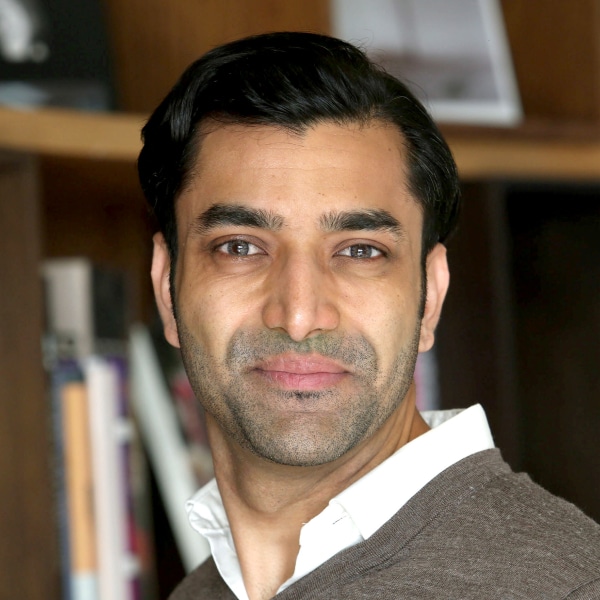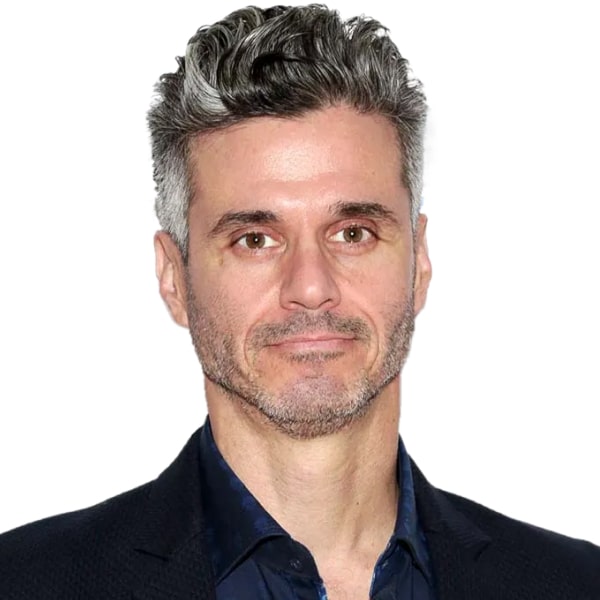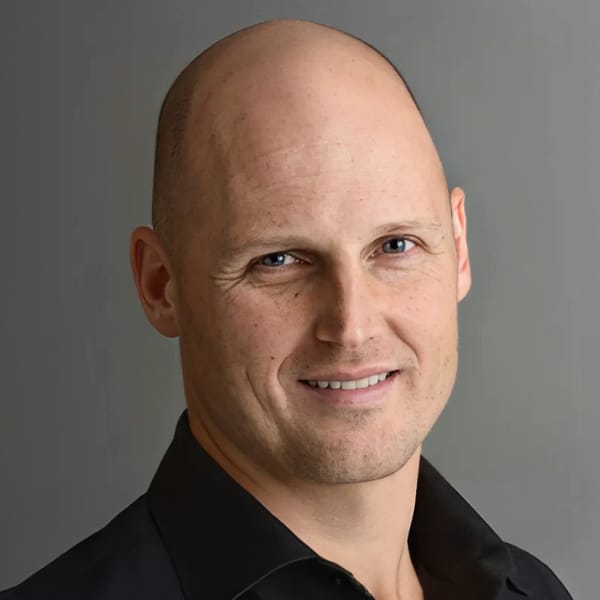Reshaping Industries With AI & ML
Alani Kuye
Chief Growth Officer at Mande Network

Tessa Burg welcomes Alani Kuye back to discuss more detail about artificial intelligence (AI) and machine learning (ML). In this conversation, Tessa and Alani discuss how AI and ML reshape industries and the dramatic shift from Web3 to AI funding.
“AI is a tool. It’s an enabler. It’s not the answer.”
Discover the importance of foundational business practices and learn about the critical role of big data, neural networks and human expertise in guiding AI development. Understand the significance of collaboration, user experience and simplification in successfully scaling technology.
Get an expert take on the future of agencies and the impact of AI on various professions.
Topics In This Episode:
- AI/ML funding shift
- Startup funding trends
- Business practices and modeling
- Web3 to AI/ML pivot
- Data utilization in AI/ML
- Specialized AI applications
- Human expertise in AI
- Up-skilling and re-skilling
- Collaboration in AI adoption
- Process simplification
- Future of knowledge work in AI
Watch the Live Recording
Tessa Burg: Hello, and welcome to another episode of “Leader Generation,” brought to you by Mod Op. I’m your host, Tessa Burg, and I am joined once again by Alani Kuye. This is the second part of our conversation where we explore the bridge between AI and ML and the impact that it’s having on multiple industries around the world. Thank you again for joining us. I’m excited to continue this conversation.
Alani Kuye: Yes, thank you for having me. Always a pleasure.
Tessa Burg: So we were left off with a conversation around startups and the coaching and advisement you give startups, and really, the importance of making sure that founders are willing to put in the work that’s necessary to bring an idea to an operational model. And one thing that we’ve observed, and we were just talking about this, is it’s been easier for startups to raise funds to get money. And first it was Web3 and all these Web3 startups were being funded, and now it’s AI, and all these AI machine learning startups are being funded. What’s going on in this space? Why was there such a dramatic shift into a different direction and so quickly?
Alani Kuye: Yes, and thank you Tessa, that’s a very, very, very acutely accurate question given where we are today. You know, Web3 decentralized access. When a company will typically spend 10, 15, $20,000 a month for their cloud hosts and infrastructure, Web3 made that literally 10, 20, maybe $100 a month on decentralized infrastructure. So what happened, what came with that is tokenization where any projects could launch a crypto token and overnight, ICO and poll tens or hundreds of millions of dollars, literally. And we’ve seen many of these happen where companies just raised $80 million in four hours just by launching a token. Of course, such overnight windfalls, at least with bad habits, fundamentals get ignored for convenience. So the typical process that requires operations modeling, business modeling, understanding, we were talking about earlier, the dirty math around building a sustainable business that solves for the demand side prior to the supply side, those rules got tossed out the door. So you have a lot of projects built on Web3 that are what I call solutions, looking for problems. Because it was so easy to access resources and capital via tokenization, every project had its own crypto. Obviously, fast forward, it’s been about a decade now, this has been happening. And many of them, you can see the Forbes article that came out, literally, this morning about quote, unquote, “Good for nothing block chains,” that have billions of dollars in treasury. They make less than $6,000 a month. Some, barely no one uses ’em. But when you’re sitting on all that capital and time has gone by without demonstrating value, what happens is, naturally, these projects start to look for the next big thing. So think of it as a project that’s quite frankly failed, but has a lot of cash to burn. So obviously the next big thing, AI ML being what’s in the news now, they all do a hard pivot, right? When really AI ML is a bridge to the next thing. So you have a lot of treasuries burning through cash with no value, looking for something to latch onto. So they come in, flush with cash, with resources, and that’s the next big thing. So the reason for that pivot, quite frankly, many of these projects have no business in AI, period. But the burden for resources has been eliminated. They already have ecosystems, they have grant programs, they are flush with cash from prior ICO events. So oftentimes what you’d see is the actual chain protocol has a foundation, and that foundation invests in all this AI projects, hoping one hits because they have a lot of liquidity, and that’s going to continue for a while.
Tessa Burg: So when you said AI and ML is actually the bridge to the next thing, do we know what the next thing is, and is there, like, I know there are Web3 solutions that make use of AI and ML and have those startups now found the problems that they can solve because they can use AI and ML within the network? Either where are the bridges or how can startup founders find them efficiently to create that value?
Alani Kuye: So value comes from solving a problem at scale. On the other hand, you can’t scale what you can’t simplify. On the third hand, in order to simplify something, you have to practice, practice. So repetition leads to expertise. In the tech space that requires a lot of data. So the hard swing back, so AI ML is now pulling everybody back to Web2 because that’s where all the data sits. So think about Google’s Gemini, think about Microsoft’s AI. Think about open AI, for example. Think about Salesforce, think about Oracle. Let’s exclude chat GPT for a minute there. Let’s just take all those companies that have been around for a while that have AI applications sitting on their massive data sets. They’ve had 20, 30, in some cases, 40 years of data that they’ve gathered over that period. So of course, going in, that’s where big data comes from. They have the data sets to really mine to produce useful information, ’cause you convert raw data into useful information under presentation layer. And that’s where we’re getting into neural networks. So each node on the network, so we’ll take Microsoft for example, SharePoint, right? Office applications, CRM, they have all of the deep data sets. Each node on their neural network can supply the data for the AI ML applications to read from, in most cases, enterprise closed environments. Whereas you have the Web3 shops that are flushed with cash, pivoting to AI. They don’t have that incumbency because they spent years building crypto and it’s been so focused on tokenization that they haven’t really invested in that. So they have to go license data from the incumbents. So that’s why I said earlier, and pivot for a second, actually, the Web3 shops had also operated on the premise of we’re going to replace Web2. So it goes back to my point of they’ve built walls for the last decade where they should have been building bridges. So now they’re trying to build bridges back to Web2. Unfortunately, the incumbents in Web2 are coming up with their own AI platforms. So there’s less reliant on the Web3 shops. So that’s where we are seeing that friction come about. Finally, where this is going, the next thing is specialization, based on what we are seeing so far. So we get into neural networks and transformer models, context. Very brief example, if you take a statement, “The boy is going home,” as language structure, subject, verb, object, and the AI system looks for the relationship between words relative to language structure and characters. So “The boy is going home,” the boy is a subject, the verb is going, home, object. Period, that’s a statement. If you plug that into an AI system, it’s gonna ask you for context. That’s where transformer models come in. Transformer models look for context. So if you say, “Alani is going home,” it’ll ask you, “Why is Alani going home? Please provide context,” right? In a closed enterprise environment, for example, legal AI for example, if it’s around a case, Alani is mentioned in that case, then it will look for all the relationships to Alani and give you the options. Transform a modeling context. Any AI system doesn’t have that. This is why there’s been quite a few lawyers in the state of New York that have been disbarred, and this is all over the news. But just plug in something into Chat GPT and they go cite that case law in court that never existed in the first place. So that next thing is cleaner transformer models based on context specialization. And we see some of it already. Legal technology AI, that’s immersion. Healthcare AI, that’s immersion. If you go to an oncologist, for example, and they plug in all your case file into the system, and it reads all their information, this person exhibits X, Y, Z behavior, based on case file one, two, three, four, five, what are possible… So we start to see refinement, and it’s nothing new. So what I believe is the next big thing is specialization, and AI is the bridge to get into that.
Tessa Burg: When we think about the human side of that, a lot of people have built their careers in specific industries and have specific expertise in that industry, whether it’s sales, or marketing, or engineering. Where is the opportunity for people who have spent their career in an area, and they know AI and ML is coming, and they know that things that they are doing now or the knowledge that they have is being automated, if we’re moving towards context and specialization, what is the role for experts within that space?
Alani Kuye: I mean, I’ve listened in my experience, back in the day, we had something called decision support systems, right? DSS, and it’s the same thing today. We had Crystal Reports, early days of business intelligence, Microsoft. So we had all these tools, which is no different from AI today. The only difference is as a presentation layer. Back then, you plugged in the data, your query databases and you pumped out charts, and you had a war room. You had your team in the room and you’re analyzing all the data bit by bit. And then algorithms showed up, right? That could plug it into even fancier graphs, right? But now it’s conversational, it’s the same info. So we’re taking data and we are presenting it on a much more broader scale, horizontally, right, in human-readable format. Now the experts actually have a role to play. I think they become leaders in the space because they provide governance, they provide context, and they actually help guide the evolution of AI. Look at it this way, if you do the same thing every day, of course you’re gonna be threatened. Because again, AI comes from fixed data sets of a repetitive nature with variances, right? So programmers for example, certain languages are gonna be threatened by AI. I mean, I put three million thread in two minutes from Gemini, which we would’ve paid a developer a quarter million dollars a year to do that, you know? But again, that doesn’t put that dev out of work. It just means it’s time to level up. And I think what that does is it becomes a force and function, right, for professionals to come take assessment of our skills, where we really want to go with it, right, and how we can bring that expertise from a govern… Because it’s still humans writing the code, it’s still humans running the models, okay? It is still humans providing the context. So at what point do we, as professionals, say, how can we govern this technology that we are building in a way that serves us so we are not reliant on it to make decisions. We use the example of the lawyers that have been disbarred for just plugging things into GPT, and then go cite it in court. Same thing with students, I mean, when I went to college, we had to write papers. I mean my dissertation was almost 300 pages and I had to defend it, you know, but today, kids would just go plug it in GPT and get the highlights, and call it a day. So we have to find ways to provide governance and direction for this technology, but it only happens if we collaborate. Unfortunately, A CFO won’t look at it that way. A CFO wants to trim costs. A CEO’s looking for efficiency at the bottom line, right? A CMO wants to present the optics that we are all on the cutting edge of technology. So agendas are different, but somewhere we have to bring it all together in a way that doesn’t leave anybody behind, by choice.
Tessa Burg: Yeah, I think that is really challenging because sometimes the people who have been putting in the practice and the work and have been doing the repeatable tasks over and over again, are not always the same people who can see the opportunity and where those exact tasks can be automated to extract more value, but also that value translate into opportunities for themselves. But then you have on the other half, startups and people who don’t have that practice, who don’t have that expertise in context, trying to chase a problem to solve. And so it’s really important that there’s a lot of empathy and some of these folks will be displaced and they do have a lot of value and what does that look like in that up-skilling re-skilling path for them to continue to provide that very necessary context that will actually make the solution the most effective and powerful. And I do think we tend to skip steps and say like, “Well where was the time savings right now?” And it’s like, but to get there, we first have to get really clear on why we’re automating and the value creation that’s happening. And then the time, then the time will be saved.
Alani Kuye: Yeah, I mean it’s also ecosystems, right? So in the Web3’s fair, for example, originally, when many of these projects built ecosystems, it was just, let’s get a bunch of software engineers who are crypto natives, just like us. They speak Kubernetes, they speak Java, and we’ll just all build ML’s ecosystem. And one of the things I did earlier on is I actually wrote a paper. It’s published in SSRN, on governance models, and how to align that with ecosystems because their ecosystem participants are not just devs, they’re bloggers, media personalities, they’re students, carpenters, architects, contributors, people who are just curious, and just broaden it. Because what happens is, when you go horizontal, you learn a lot more about how people want to use the technology and you provide more value, and you give people an opportunity to be a part of that. Because all you have to do is give people an opportunity to take ownership and feel they’re a part of it, then the work becomes easier because you have a diverse set of views. Same thing with AI ML, when we implement these things, it’s not a zero sum game, right? It’s the earlier on we engage our people so they understand the why and what role they play in that process, then it becomes a working contract. And the earlier on people can take ownership of a piece of work, the better the quality. It’s easier said than done, but it’s also easy by just having that conversation. Because what happens is, to your earlier point, it’s cost savings are precious. You still have a business to run, right? But what’s that engagement model like, where we say we are going to be introducing a set of tools over the next few quarters, two, three quarters, this is what they do. We’d like input from everyone here, share ideas. Of course you’re gonna get a lot of ideas, but that’s easier than saying we are going the AI route because it’s gonna save us $20 million, and in the next few months, there’s gonna be structural changes. So people don’t like surprises. And sometimes our reaction to certain things is actually worse than the event itself, right? So by not surprising and just engaging people, no one’s gonna be left behind. That’s just the reality of it.
Tessa Burg: So I think with capitalistic pressures, there will still be companies, that even if they haven’t received measurable results from executing AI and ML, and we’ve seen this already, they’ll just let people go and say like, “Oh, well you know, now that we’re using AI and ML, we don’t need these people.” And then on the other side, there’s predictions that we’re gonna start to see billion dollar companies run by one or two people. I’m gonna put you on the spot, but do you have any predictions around when we think about those companies, these high value companies that are going to start sprouting up, that’s one or two folks, what kinds of businesses are those going to be?
Alani Kuye: Quite frankly, that’s already happening. And I happen to know a few of those where there are three guys and their market cap is over $2 billion.
Tessa Burg: Oh my gosh,
Alani Kuye: It’s already happening. But we have to introspectively look at this situation. Is this an anomaly or is this where everything is going?
Tessa Burg: Mmhmm.
Alani Kuye: Correct, because the tools are available and it’s easier than it ever was. So everyone has access today, but the issue really is how are we balancing it with… For example, there’s certain industries that disruption is expected. If you go to McDonald’s or any of these fast food joints, I mean, I’m not a fast food guy, but I look at all the data points and what happens in the news. You want to pay people $25 an hour to flip a burger, okay? 30,000 people in a region of the country. Okay, I can invest $20 million instead and have self order, self checkout, then I’m not exposed to labor laws, union laws, all of those things. That’s a business decision. On the other hand, it could be, how can I up-skill our existing working pool, give them an opportunity to either opt in or opt out. So it’s not an issue of we are replacing people with technology. So my point all along is we can either work collaboratively via sensible engagement, right, or we can go the purely capitalistic route. Unfortunately we live in a society today where capitalism first, short term gains, then come what may. And then sometimes, we go through this cycle, right? This cycles where there’s a boom as a bust, we come back, so it swings in either direction every seven or so years, and we’re going through that cycle again.
Tessa Burg: Yeah. So what industries are the $2 billion companies already in? I’m curious.
Alani Kuye: Funny enough, it’s in AI and it’s in Web3. So the first one, actually, as a matter of fact, well they’re a global company, but headquartered on the books in Singapore, and they’re simply an exchange that says you can have, Ethereum and you wanna swap it for Cardano or whatever token, right, and you can also launch your own token on the platform. It’s run by three people, okay? I can go into there and I launch Alani token, and Alani token makes a plugin for this ledger device that holds bitcoins or whatever’s on it, and you can just swap it. And I just launched a token there, and anybody could do it. And what happened? Everyone started… It’s not even a popular decentralized exchange, okay? And it is a market cap of almost two billion, actually. And this is a nine month project. Same thing with AI. So Sensei, that is actually on LinkedIn, Sensei. Another project, it’s an AI ML tool. It’s just like a little app and you just talk to it and they store all your information, and they store it perpetually on the internet. So if a person passes away, the AI sensitizes those conversation, masters the person’s voice so their loved ones can still have conversations with them.
Tessa Burg: Oh my gosh
Alani Kuye: Virtually, which I find very creepy. That’s just my personal opinion, you know? But he just raised 200 million, and two of them, $3 billion valuation. That was my point earlier.
Tessa Burg: Yeah.
Alani Kuye: I could throw in money.
Tessa Burg: Yeah, I guess this is kind of creepy, but I have voicemails from my late uncle that I, every now and then we’ll play. And so I get the appeal, where it’s like you do just sort of want to hear the voice, get that comfort, but that’s wild.
Alani Kuye: Yeah, no, I did the same thing. My favorite uncle, he lived in New Jersey for a long time. I saved all of his voicemails, and he’s been gone a long… I would just sometimes just listen to it ’cause I was very close to him. I did the same thing, but real time conversations? It’s just like a bad thriller movie that, I don’t know, I have my own reservations about. There’s a reason, there’s something called a cycle of life, and I prefer to take a bouquet of flowers to a gravestone than having a conversation with Tony Stock. There’s something unsettling about it, but again, and who’s their largest investor? A company I shall not name that’s on that list of good for nothing block chains that I sent you that came out of Forbes this morning.
Tessa Burg: Oh my gosh.
Alani Kuye: Yeah. So that’s the pivot I was talking about earlier, where you have a blockchain company with over a billion dollars in their treasury and no one uses it, they make $5,000 a month. They’ve been around for 10 years, and now they’ve dumped $200 million into the next big AI thing that’s supposed to talk to dead people. So where is the account? That’s why it goes back to fundamentals, ’cause a real venture capitalist, a real investor, will put you through the paces to understand you’ve done your due diligence, you’ve done your research, you’ve thought this through, and the numbers make sense before writing a check.
Tessa Burg: Yeah. No, I agree. It’s a time, and we hit on this in the first conversation, of people are still experimenting and still learning, and we are not at a place where we fully appreciate or understand what the impact will be. But it’s important that we continue to collaborate to value expertise, to not try and shortcut the work or find the shortest path to efficiency or quick wins.
Alani Kuye: Correct.
Tessa Burg: For the majority of our audience are marketers, and I think there’s this fear, and again, some of this has already become reality where knowledge work and largely agencies, so Mod Op is an agency, and we produce creative in all forms, will ultimately go away. Whether companies, like if you can start a business with two to three people, can you run an entire marketing department within your company with just two to three people? And then what will be the value of an agency that’s hundreds of people? What are your thoughts on that? And we’re not the only industry. I think a lot of accounting firms, law firms, you could name any firm, engineering, architects, any firm that’s built on knowledge work, what will be the future of firms versus companies just taking those types of services in-house?
Alani Kuye: I think part of the promise of AI is a more efficient, cost-effective, data-driven approach to solving problems. Many of these professions in themselves have become rackets. The same way crypto, Bitcoin, for example, was a response to the financial global Cummins that you can no longer trust and hold accountable. Take law for example, people forget, no matter what the outcome of a case is, the only person guaranteed to go to the bank smiling is a lawyer. It’s in their interest to drag a case out as long as possible so they can get billable hours. An accountant isn’t paid to do your books and file your taxes. Their job is to find loopholes in the tax code to maximize, okay, the financial position. A doctor’s job isn’t to keep you healthy. A doctor’s job is to enable you, advise you, make the right decisions for your health, okay? Going to a doctor is not an excuse to live an unhealthy lifestyle. So when we start to think of these things, all of life that way, we look at AI as a tool. It’s an enabler, it’s not the answer. So marketing teams, for example, their job is not to, quote unquote, make you successful. Their job is to provide guidance, expertise, and knowledge to enable you attain whatever objective you set out to obtain. Sometimes it’s a wider reach, sometimes it’s to clean up your messaging so that it reaches the right audiences in the lowest cognitive load, manner possible. And sometimes it’s just to repair a damaged brand. So we have to start to understand the important roles that these individuals or teams play relative to the tools available to us. Having a Twitter account doesn’t automatically get you engagement. Having a million followers doesn’t guarantee engagement. A marketer’s job is to advise you on how to use those tools in the most cost efficient and impactful ways possible. So we, as humans, have to think about that first and not look as a tool as a replacement for common sense.
Tessa Burg: Yeah. I love that answer. I agree. I remember when I first started in marketing. So I came out of IT and development and just thought PR looked like the coolest thing. So I tried to get a PR job and sort of lucked out and was given an opportunity to work at a brand agency. And the internet, to them, was still very new. But to me, I’d been working in the space, at that point, for five or six years, started at my uncle’s company, I just referenced. And a lot of people, I remember during this time, this is right after the bubble burst was that things are gonna get replaced. You have to know how to develop a website. If you don’t know how to do these things, then you will not be successful. You will not be a company. But those were really just other platforms for expression and communication. It didn’t mean that your expertise and your ability to see across industries, to be creative were being replaced. But what agencies did certainly did change. They went from hand drawings and ads in newspapers to different types of digital experiences, and using different tools to get the message out. And that’s, as a marketer, what I get most excited about, and as a marketer in technology is what’s next for us to create with these tools? Not that our job is to pump out a bunch of pictures in any form. Our job is to use the tools to create and to be imaginative and to solve really big, sticky problems. And we get the advantage of seeing these solutions across so many clients. And that’s my favorite part, and I’m sure again, those other professions probably feel the same. If you’re an architect, you see similar problems across many different projects, and you are able to use the tools more efficiently because you’ve tried it so many times, because you have the different perspectives.
Alani Kuye: Yeah. It’s the experience. So you turn everything into an experience. So this is where the expertise of marketers and professionals in these fields come in. So AI won’t sell you an experience. AI would present data sets to you. You think about, there’s an old saying, I believe it was Maya Angelou, “People forget what you did, they forget what you said, but they never forget how you made them feel,” okay. And marketers, that’s the whole point, experiential-ize it. That’s why most marketers come to technology and the first thing they tell you is, “Who did you build this for, robots or humans?” Okay, lower the cognitive load because what keeps people coming back is if they can enter and exit a position comfortably. It’s that simple. And nowhere else in Web3 or technology is it more evident than AI. Most people don’t even know where to start. They think chat GPT, no, there’s more to AI than that. It’s just the entry point.
Tessa Burg: Yeah.
Alani Kuye: Right? So we can’t dislodge the human component and those experiences, that’s why most AI shops, if you look at the highest paid people on those teams are usually the non-tech folks, they’re the marketers. Okay, they call ’em prompt engineers now, because they understand, and that’s the human touch. That is that expertise, that experience understanding how focus groups work, how people react, how heat map maps work, what’s a copy versus the fold? How are people behave when they interact in technical environments? AI won’t figure that out. AI will build you a website. AI could generate some fancy images, right? Once that’s done, then what? It still has to go to humans. Those who consume that information are the ones who ultimately will determine the success or failure. So if humans are gonna consume it, who should govern it? Of course, fellow humans who are professionals and experts in that field with which we’re trying to create messaging for. So I do believe, as I said earlier, it’s a bridge to the next big thing, and that is going to be specialization because we already see that happening in the enterprise space. Salesforce has its own AI, you don’t see them on the news talking about it because they have a customer base. They have 20 years worth of data, siloed data, multiple nodes on the neural network that they can read from, so they don’t have to be out there competing, because in the enterprise space, governance, accountability, regulatory, there’s so many constraints structurally, GDPR privacy laws that they have to contend with. So naturally they’ll build better systems. I mean, that’s the nature of the beast. So that’s why being a bridge to the next big thing, yes, when that comes into the public domain, I think we’ll really start to see the value, the key value proposition of promise of AI.
Tessa Burg: I agree. So we’re at time again-
Alani Kuye: Oh, right.
Tessa Burg: Is there any last words that you wanna leave the listening audience with before we go?
Alani Kuye: I think any executive should always, always think of users and experiences because if you’ve gained nothing from this conversation, I’ll leave you with these words. You can’t scale what you can simplify. Low cognitive load, accelerated adoption, high cognitive load, decelerated adoption.
Tessa Burg: And I think that’s so important as a lot of companies are trying to figure out what do we build, what do we build? And if they repeat that to themselves, I love that, you can’t scale what you can’t simplify. And that’s-
Alani Kuye: Simple.
Tessa Burg: Yep. Well, thank you so much for coming back a second time and being a guest.
Alani Kuye: Thank you.
Tessa Burg: Great conversation. And if people have more questions for you, where can they find you?
Alani Kuye: Alani Kuye, there’s only one Alani Kuye on Twitter, on LinkedIn, on YouTube. Yeah, Instagram Alani Kuye. There’s only one me and my work is very public, so you don’t have to look far at all.
Tessa Burg: That is perfect. And if you missed the first episode, you can visit ModOp.com, M-O-D-O-P dot com and find all of our podcasts on the podcast page. And we’re also on LinkedIn at Leader Generation. And until next time, we’ll catch up with you soon.
Alani Kuye: All right, thank you.
Alani Kuye
Chief Growth Officer at Mande Network

Alani is a seasoned technology executive with over 20 years of experience scaling platforms, building technology ecosystems, startup acceleration and investing. He’s passionate about leveraging blockchain technology, decentralized platforms and artificial intelligence to create decentralized global ecosystems that empower people and businesses. Alani also published multiple papers on blockchain governance frameworks. Connect with Alani on LinkedIn.




